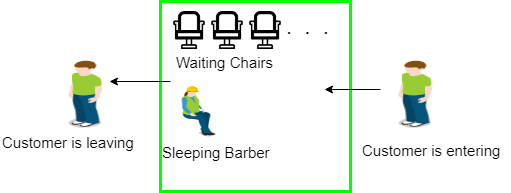Problem : The analogy is based upon a hypothetical barber shop with one barber. There is a barber shop which has one barber, one barber chair, and n chairs for waiting for customers if there are any to sit on the chair.
- If there is no customer, then the barber sleeps in his own chair.
- When a customer arrives, he has to wake up the barber.
- If there are many customers and the barber is cutting a customer’s hair, then the remaining customers either wait if there are empty chairs in the waiting room or they leave if no chairs are empty.

Solution : The solution to this problem includes three semaphores.First is for the customer which counts the number of customers present in the waiting room (customer in the barber chair is not included because he is not waiting). Second, the barber 0 or 1 is used to tell whether the barber is idle or is working, And the third mutex is used to provide the mutual exclusion which is required for the process to execute. In the solution, the customer has the record of the number of customers waiting in the waiting room if the number of customers is equal to the number of chairs in the waiting room then the upcoming customer leaves the barbershop.
When the barber shows up in the morning, he executes the procedure barber, causing him to block on the semaphore customers because it is initially 0. Then the barber goes to sleep until the first customer comes up.

Algorithm for Sleeping Barber problem:
Semaphore Customers = 0;

Post a Comment